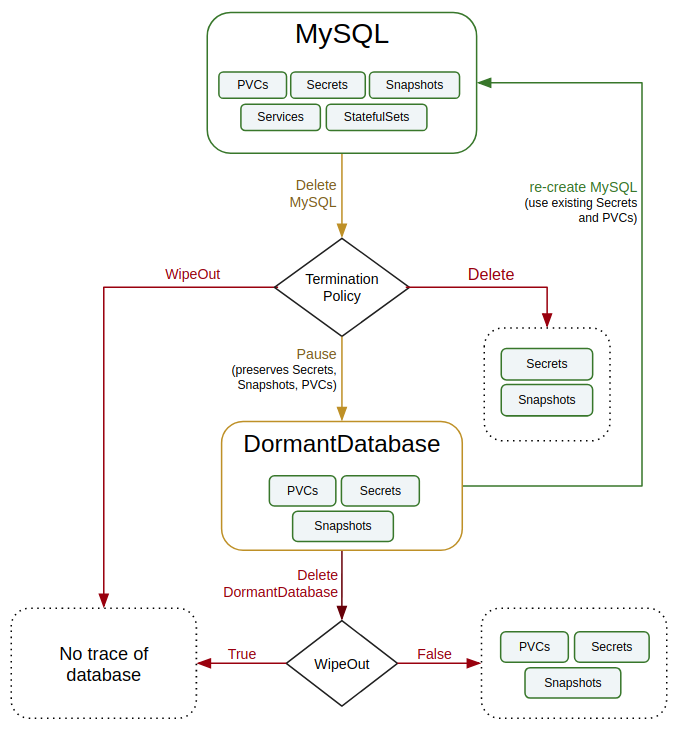You are looking at the documentation of a prior release. To read the documentation of the latest release, please
visit here.
New to KubeDB? Please start here.
MySQL QuickStart
This tutorial will show you how to use KubeDB to run a MySQL database.

Note: The yaml files used in this tutorial are stored in docs/examples/mysql folder in GitHub repository kubedb/docs.
Before You Begin
At first, you need to have a Kubernetes cluster, and the kubectl command-line tool must be configured to communicate with your cluster. If you do not already have a cluster, you can create one by using Minikube.
Now, install KubeDB cli on your workstation and KubeDB operator in your cluster following the steps here.
StorageClass is required to run KubeDB. Check the available StorageClass in cluster.
$ kubectl get storageclasses NAME PROVISIONER AGE standard (default) k8s.io/minikube-hostpath 4hTo keep things isolated, this tutorial uses a separate namespace called
demothroughout this tutorial. This tutorial will also use a phpMyAdmin deployment to connect and test MySQL database, once it is running. Run the following command to prepare your cluster for this tutorial:$ kubectl create ns demo namespace/demo created $ kubectl create -f https://github.com/kubedb/docs/raw/v0.13.0-rc.0/docs/examples/mysql/quickstart/demo-1.yaml deployment.extensions/myadmin created service/myadmin created $ kubectl get pods -n demo --watch NAME READY STATUS RESTARTS AGE myadmin-c4db4df95-8lk74 0/1 ContainerCreating 0 27s myadmin-c4db4df95-8lk74 1/1 Running 0 1m $ kubectl get service -n demo NAME TYPE CLUSTER-IP EXTERNAL-IP PORT(S) AGE myadmin LoadBalancer 10.105.73.16 <pending> 80:30158/TCP 23m $ minikube ip 192.168.99.100Now, open your browser and go to the following URL: http://{minikube-ip}:{myadmin-svc-nodeport}. You can also get this URl by running the following command:
$ minikube service myadmin -n demo --url http://192.168.99.100:30158
According to the above example, this URL will be http://192.168.99.100:30158. The login informations to phpMyAdmin (host, username and password) will be retrieved later in this tutorial.
Find Available MySQLVersion
When you have installed KubeDB, it has created MySQLVersion crd for all supported MySQL versions. Check 0
$ kubectl get mysqlversions
NAME VERSION DB_IMAGE DEPRECATED AGE
5 5 kubedb/mysql:5 true 29s
5-v1 5 kubedb/mysql:5-v1 true 29s
5.7 5.7 kubedb/mysql:5.7 true 29s
5.7-v1 5.7 kubedb/mysql:5.7-v1 29s
5.7-v2 5.7.25 kubedb/mysql:5.7-v2 29s
5.7.25 5.7.25 kubedb/mysql:5.7.25 29s
8 8 kubedb/mysql:8 true 29s
8-v1 8 kubedb/mysql:8-v1 true 29s
8.0 8.0 kubedb/mysql:8.0 true 29s
8.0-v1 8.0 kubedb/mysql:8.0-v1 29s
8.0-v2 8.0 kubedb/mysql:8.0-v2 29s
8.0.14 8.0.14 kubedb/mysql:8.0.14 29s
8.0.3 8.0.3 kubedb/mysql:8.0.3 29s
Create a MySQL database
KubeDB implements a MySQL CRD to define the specification of a MySQL database. Below is the MySQL object created in this tutorial.
apiVersion: kubedb.com/v1alpha1
kind: MySQL
metadata:
name: mysql-quickstart
namespace: demo
spec:
version: "8.0-v2"
storageType: Durable
storage:
storageClassName: "standard"
accessModes:
- ReadWriteOnce
resources:
requests:
storage: 1Gi
terminationPolicy: DoNotTerminate
$ kubedb create -f https://github.com/kubedb/docs/raw/v0.13.0-rc.0/docs/examples/mysql/quickstart/demo-2.yaml
mysql.kubedb.com/mysql-quickstart created
Here,
spec.versionis the name of the MySQLVersion CRD where the docker images are specified. In this tutorial, a MySQL 8.0-v2 database is going to be created.spec.storageTypespecifies the type of storage that will be used for MySQL database. It can beDurableorEphemeral. Default value of this field isDurable. IfEphemeralis used then KubeDB will create MySQL database usingEmptyDirvolume. In this case, you don’t have to specifyspec.storagefield. This is useful for testing purpose.spec.storagespecifies the StorageClass of PVC dynamically allocated to store data for this database. This storage spec will be passed to the StatefulSet created by KubeDB operator to run database pods. You can specify any StorageClass available in your cluster with appropriate resource requests.spec.terminationPolicygives flexibility whether tonullify(reject) the delete operation ofMySQLcrd or which resources KubeDB should keep or delete when you deleteMySQLcrd. If admission webhook is enabled, It prevents users from deleting the database as long as thespec.terminationPolicyis set toDoNotTerminate. Learn details of allTerminationPolicyhere
Note: spec.storage section is used to create PVC for database pod. It will create PVC with storage size specified instorage.resources.requests field. Don’t specify limits here. PVC does not get resized automatically.
KubeDB operator watches for MySQL objects using Kubernetes api. When a MySQL object is created, KubeDB operator will create a new StatefulSet and a ClusterIP Service with the matching MySQL object name. KubeDB operator will also create a governing service for StatefulSets with the name kubedb, if one is not already present. No MySQL specific RBAC permission is required in RBAC enabled clusters.
$ kubedb describe my -n demo mysql-quickstart
Name: mysql-quickstart
Namespace: demo
CreationTimestamp: Wed, 06 Feb 2019 17:17:55 +0600
Labels: <none>
Annotations: <none>
Replicas: 1 total
Status: Running
StorageType: Durable
Volume:
StorageClass: standard
Capacity: 1Gi
Access Modes: RWO
StatefulSet:
Name: mysql-quickstart
CreationTimestamp: Wed, 06 Feb 2019 17:17:55 +0600
Labels: kubedb.com/kind=MySQL
kubedb.com/name=mysql-quickstart
Annotations: <none>
Replicas: 824641282668 desired | 1 total
Pods Status: 1 Running / 0 Waiting / 0 Succeeded / 0 Failed
Service:
Name: mysql-quickstart
Labels: kubedb.com/kind=MySQL
kubedb.com/name=mysql-quickstart
Annotations: <none>
Type: ClusterIP
IP: 10.99.24.103
Port: db 3306/TCP
TargetPort: db/TCP
Endpoints: 172.17.0.8:3306
Database Secret:
Name: mysql-quickstart-auth
Labels: kubedb.com/kind=MySQL
kubedb.com/name=mysql-quickstart
Annotations: <none>
Type: Opaque
Data
====
password: 16 bytes
username: 4 bytes
No Snapshots.
Events:
Type Reason Age From Message
---- ------ ---- ---- -------
Normal Successful 2m KubeDB operator Successfully created Service
Normal Successful 53s KubeDB operator Successfully created StatefulSet
Normal Successful 53s KubeDB operator Successfully created MySQL
Normal Successful 53s KubeDB operator Successfully created appbinding
Normal Successful 53s KubeDB operator Successfully patched StatefulSet
Normal Successful 53s KubeDB operator Successfully patched MySQL
$ kubectl get statefulset -n demo
NAME READY AGE
mysql-quickstart 1/1 2m22s
$ kubectl get pvc -n demo
NAME STATUS VOLUME CAPACITY ACCESS MODES STORAGECLASS AGE
data-mysql-quickstart-0 Bound pvc-652e02c7-0d7f-11e8-9091-08002751ae8c 1Gi RWO standard 10m
$ kubectl get pv -n demo
NAME CAPACITY ACCESS MODES RECLAIM POLICY STATUS CLAIM STORAGECLASS REASON AGE
pvc-652e02c7-0d7f-11e8-9091-08002751ae8c 1Gi RWO Delete Bound demo/data-mysql-quickstart-0 standard 11m
$ kubectl get service -n demo
NAME TYPE CLUSTER-IP EXTERNAL-IP PORT(S) AGE
kubedb ClusterIP None <none> <none> 11m
myadmin LoadBalancer 10.105.73.16 <pending> 80:30158/TCP 41m
mysql-quickstart ClusterIP 10.104.50.139 <none> 3306/TCP 11m
KubeDB operator sets the status.phase to Running once the database is successfully created. Run the following command to see the modified MySQL object:
$ kubedb get my -n demo mysql-quickstart -o yaml
apiVersion: kubedb.com/v1alpha1
kind: MySQL
metadata:
creationTimestamp: "2019-02-06T11:17:55Z"
finalizers:
- kubedb.com
generation: 2
name: mysql-quickstart
namespace: demo
resourceVersion: "2158"
selfLink: /apis/kubedb.com/v1alpha1/namespaces/demo/mysqls/mysql-quickstart
uid: d9b37fc3-2a00-11e9-a088-080027ab5700
spec:
databaseSecret:
secretName: mysql-quickstart-auth
podTemplate:
controller: {}
metadata: {}
spec:
resources: {}
replicas: 1
serviceTemplate:
metadata: {}
spec: {}
storage:
accessModes:
- ReadWriteOnce
dataSource: null
resources:
requests:
storage: 1Gi
storageClassName: standard
storageType: Durable
terminationPolicy: DoNotTerminate
updateStrategy:
type: RollingUpdate
version: 8.0-v2
status:
observedGeneration: 2$4213139756412538772
phase: Running
Connect with MySQL database
KubeDB operator has created a new Secret called mysql-quickstart-auth (format: {mysql-object-name}-auth) for storing the password for mysql superuser. This secret contains a username key which contains the username for MySQL superuser and a password key which contains the password for MySQL superuser.
If you want to use an existing secret please specify that when creating the MySQL object using spec.databaseSecret.secretName. While creating this secret manually, make sure the secret contains these two keys containing data username and password and also make sure of using root as value of username. For more details see here.
Now, you can connect to this database from the phpMyAdmin dashboard using the database pod IP and and mysql user password.
$ kubectl get pods mysql-quickstart-0 -n demo -o yaml | grep podIP
podIP: 172.17.0.6
$ kubectl get secrets -n demo mysql-quickstart-auth -o jsonpath='{.data.\username}' | base64 -d
root
$ kubectl get secrets -n demo mysql-quickstart-auth -o jsonpath='{.data.\password}' | base64 -d
l0yKjI1E7IMohsGR
Note: In MySQL:8.0-v1 (ie, 8.0.14), connection to phpMyAdmin may give error as it is using caching_sha2_password and sha256_password authentication plugins over mysql_native_password. If the error happens do the following for work around. But, It’s not recommended to change authentication plugins. See here for alternative solutions.
kubectl exec -it -n demo mysql-quickstart-0 -- mysql -u root --password=l0yKjI1E7IMohsGR -e "ALTER USER root IDENTIFIED WITH mysql_native_password BY 'l0yKjI1E7IMohsGR';"
Now, open your browser and go to the following URL: http://{minikube-ip}:{myadmin-svc-nodeport}. To log into the phpMyAdmin, use host mysql-quickstart.demo or 172.17.0.6 , username root and password l0yKjI1E7IMohsGR.
DoNotTerminate Property
When, terminationPolicy is DoNotTerminate, KubeDB takes advantage of ValidationWebhook feature in Kubernetes 1.9.0 or later clusters to implement DoNotTerminate feature. If admission webhook is enabled, It prevents users from deleting the database as long as the spec.terminationPolicy is set to DoNotTerminate. You can see this below:
$ kubedb delete my mysql-quickstart -n demo
Error from server (BadRequest): admission webhook "mysql.validators.kubedb.com" denied the request: mysql "mysql-quickstart" can't be paused. To delete, change spec.terminationPolicy
Now, run kubedb edit my mysql-quickstart -n demo to set spec.terminationPolicy to Pause (which creates dormantdatabase when mysql is deleted and keeps PVC, snapshots, Secrets intact) or remove this field (which default to Pause). Then you will be able to delete/pause the database.
Learn details of all TerminationPolicy here
Pause Database
When TerminationPolicy is set to Pause, it will pause the MySQL database instead of deleting it. Here, If you delete the MySQL object, KubeDB operator will delete the StatefulSet and its pods but leaves the PVCs unchanged. In KubeDB parlance, we say that mgo-quickstart MySQL database has entered into the dormant state. This is represented by KubeDB operator by creating a matching DormantDatabase object.
$ kubedb delete my mysql-quickstart -n demo
mysql.kubedb.com "mysql-quickstart" deleted
$ kubedb get drmn -n demo mysql-quickstart
NAME STATUS AGE
mysql-quickstart Pausing 14s
$ kubedb get drmn -n demo mysql-quickstart
NAME STATUS AGE
mysql-quickstart Paused 39s
$ kubedb get drmn -n demo mysql-quickstart -o yaml
apiVersion: kubedb.com/v1alpha1
kind: DormantDatabase
metadata:
creationTimestamp: "2019-02-07T09:54:20Z"
finalizers:
- kubedb.com
generation: 1
labels:
kubedb.com/kind: MySQL
name: mysql-quickstart
namespace: demo
resourceVersion: "32852"
selfLink: /apis/kubedb.com/v1alpha1/namespaces/demo/dormantdatabases/mysql-quickstart
uid: 575bf14f-2abe-11e9-9d44-080027154f61
spec:
origin:
metadata:
creationTimestamp: "2019-02-07T09:46:04Z"
name: mysql-quickstart
namespace: demo
spec:
mysql:
databaseSecret:
secretName: mysql-quickstart-auth
podTemplate:
controller: {}
metadata: {}
spec:
resources: {}
replicas: 1
serviceTemplate:
metadata: {}
spec: {}
storage:
accessModes:
- ReadWriteOnce
dataSource: null
resources:
requests:
storage: 1Gi
storageClassName: standard
storageType: Durable
terminationPolicy: Pause
updateStrategy:
type: RollingUpdate
version: 8.0-v2
status:
observedGeneration: 1$5984877185736766566
pausingTime: "2019-02-07T09:54:24Z"
phase: Paused
Here,
spec.originis the spec of the original spec of the original MySQL object.status.phasepoints to the current database statePaused.
Resume Dormant Database
To resume the database from the dormant state, create same MySQL object with same Spec.
In this tutorial, the dormant database can be resumed by creating original MySQL object.
The below command will resume the DormantDatabase mysql-quickstart that was created before.
$ kubedb create -f https://github.com/kubedb/docs/raw/v0.13.0-rc.0/docs/examples/mysql/quickstart/demo-2.yaml
mysql.kubedb.com/mysql-quickstart created
Now, if you exec into the database, you can see that the datas are intact.
WipeOut DormantDatabase
You can wipe out a DormantDatabase while deleting the objet by setting spec.wipeOut to true. KubeDB operator will delete any relevant resources of this MySQL database (i.e, PVCs, Secrets, Snapshots). It will also delete snapshot data stored in the Cloud Storage buckets.
$ kubedb delete my mysql-quickstart -n demo
mysql.kubedb.com "mysql-quickstart" deleted
$ kubedb edit drmn -n demo mysql-quickstart
apiVersion: kubedb.com/v1alpha1
kind: DormantDatabase
metadata:
name: mysql-quickstart
namespace: demo
...
spec:
wipeOut: true
...
status:
phase: Paused
...
If spec.wipeOut is not set to true while deleting the dormantdatabase object, then only this object will be deleted and kubedb-operator won’t delete related Secrets, PVCs and Snapshots. So, user still can access the stored data in the cloud storage buckets as well as PVCs.
Delete DormantDatabase
As it is already discussed above, DormantDatabase can be deleted with or without wiping out the resources. To delete the dormantdatabase,
$ kubedb delete drmn mysql-quickstart -n demo
dormantdatabase.kubedb.com "mysql-quickstart" deleted
Cleaning up
To cleanup the Kubernetes resources created by this tutorial, run:
kubectl patch -n demo mysql/mysql-quickstart -p '{"spec":{"terminationPolicy":"WipeOut"}}' --type="merge"
kubectl delete -n demo mysql/mysql-quickstart
kubectl patch -n demo drmn/mysql-quickstart -p '{"spec":{"wipeOut":true}}' --type="merge"
kubectl delete -n demo drmn/mysql-quickstart
kubectl delete ns demo
Tips for Testing
If you are just testing some basic functionalities, you might want to avoid additional hassles due to some safety features that are great for production environment. You can follow these tips to avoid them.
- Use
storageType: Ephemeral. Databases are precious. You might not want to lose your data in your production environment if database pod fail. So, we recommend to usespec.storageType: Durableand provide storage spec inspec.storagesection. For testing purpose, you can just usespec.storageType: Ephemeral. KubeDB will use emptyDir for storage. You will not require to providespec.storagesection. - Use
terminationPolicy: WipeOut. It is nice to be able to resume database from previous one. So, we createDormantDatabaseand preserve all yourPVCs,Secrets,Snapshotsetc. If you don’t want to resume database, you can just usespec.terminationPolicy: WipeOut. It will not createDormantDatabaseand it will delete everything created by KubeDB for a particular MySQL crd when you delete the crd. For more details about termination policy, please visit here.
Next Steps
- Snapshot and Restore process of MySQL databases using KubeDB.
- Take Scheduled Snapshot of MySQL databases using KubeDB.
- Initialize MySQL with Script.
- Initialize MySQL with Snapshot.
- Monitor your MySQL database with KubeDB using out-of-the-box CoreOS Prometheus Operator.
- Monitor your MySQL database with KubeDB using out-of-the-box builtin-Prometheus.
- Use private Docker registry to deploy MySQL with KubeDB.
- Detail concepts of MySQL object.
- Detail concepts of MySQLVersion object.
- Want to hack on KubeDB? Check our contribution guidelines.






























